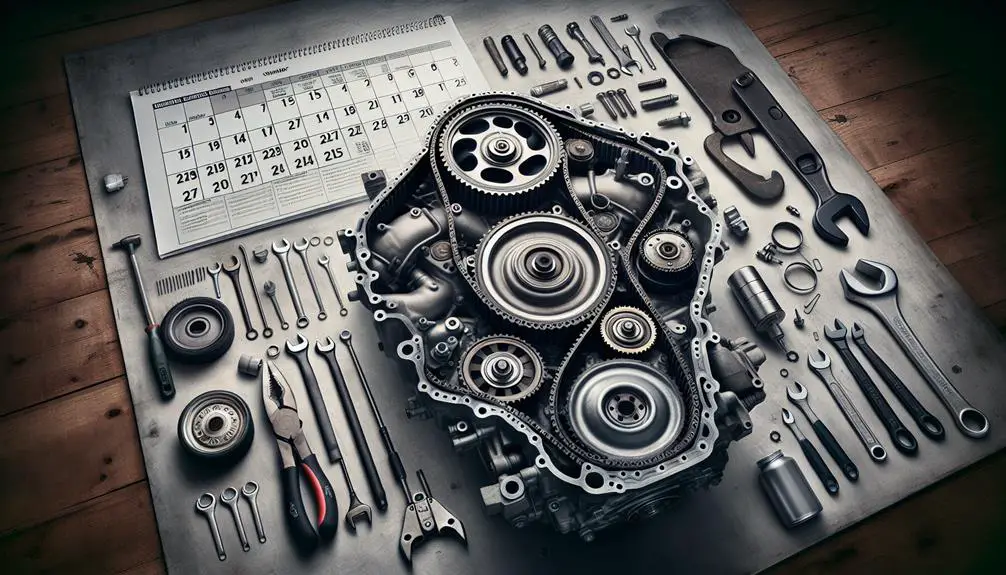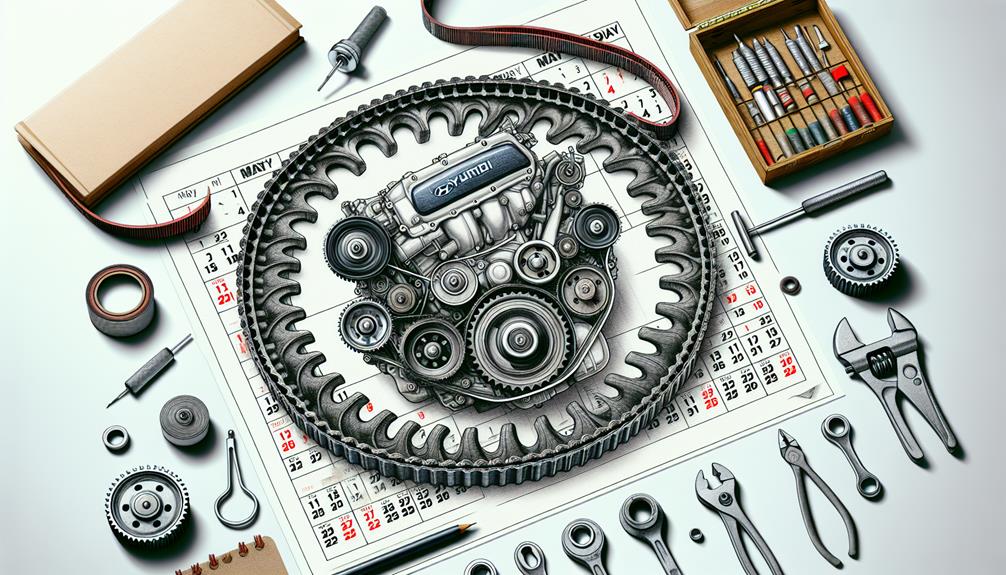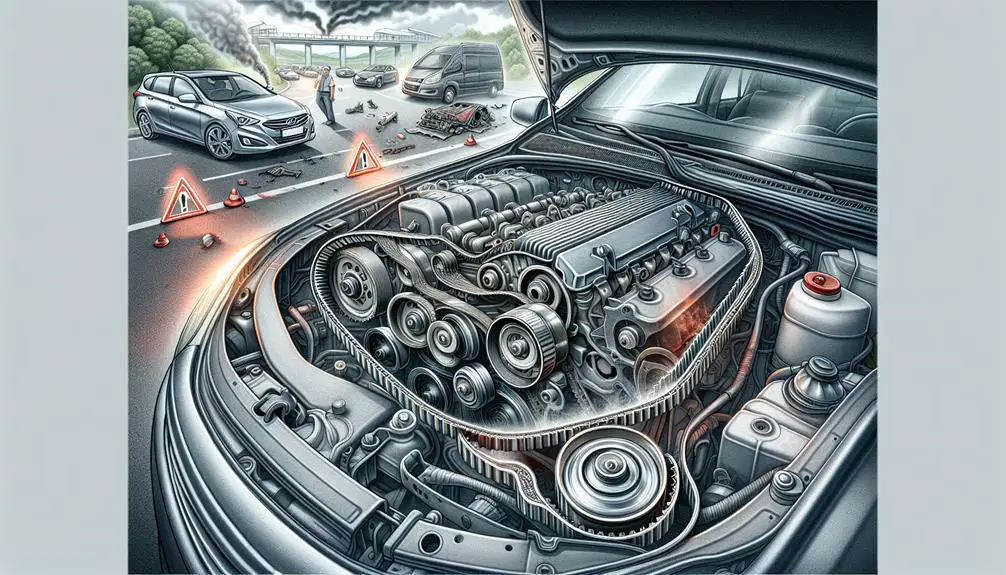Hyundai's timing belt should be replaced every 60,000 to 100,000 miles.
This maintenance is crucial to prevent engine damage and ensure proper functioning of the vehicle.
It is recommended to follow the manufacturer's guidelines for timing belt replacement to avoid any potential issues down the road.
Timing Belt Basics

To understand the importance of replacing your Hyundai's timing belt, it's important to grasp what this critical component does within the engine. The timing belt, a key part of your car's internal workings, guarantees the coordinated operation of the engine's camshaft and crankshaft. This coordination is important for the engine valves to open and close at precisely the right moments during the intake and exhaust strokes. In essence, the belt function is to maintain the engine's rhythm, preventing the pistons from striking the valves, a scenario that could lead to catastrophic engine damage.
The material composition of the timing belt is specifically designed for durability and resilience. Typically, it's made from high-grade rubber embedded with tough fibers like fiberglass or Twaron. This construction grants the belt its necessary tensile strength and resistance to wear. However, despite its sturdy nature, the belt isn't immune to deterioration over time. Its material can degrade because of different factors, including temperature fluctuations, oil contamination, and the natural aging process.
Comprehending these basics about your Hyundai's timing belt, its critical function, and its material composition underscores the importance of timely replacement to maintain engine performance and prevent potential failures.
Signs of Wear
Identifying signs of wear on your Hyundai's timing belt is crucial, as early detection can prevent extensive engine damage and costly repairs.
One of the most telling indicators is belt squealing. This high-pitched sound, often heard when starting the engine or during acceleration, suggests the belt isn't properly aligned or is wearing unevenly. It's a clear call to inspect your timing belt for any signs of degradation.
Another critical symptom to watch for is engine misfires. A worn or damaged timing belt can affect the engine's timing, leading to misfires. This occurs as the belt's teeth, which align the crankshaft and camshaft, may wear down or break. If your Hyundai's engine suddenly feels less responsive or you notice unexplained pauses during acceleration, it's likely the timing belt is struggling to maintain proper engine timing.
Both belt squealing and engine misfires are warning signs you shouldn't ignore. They suggest the timing belt is no longer able to perform its critical role effectively. Prompt inspection and, if necessary, replacement of the timing belt can save you from the inconvenience and expense of major engine repairs down the road.
Replacement Frequency

Knowing the recommended replacement frequency for your Hyundai's timing belt is essential for maintaining engine performance and avoiding costly repairs. Typically, Hyundai advises replacing the timing belt every 60,000 to 100,000 miles, but this range can vary based on model variations. It's crucial to consult your vehicle's manual or a Hyundai specialist to determine the precise interval for your specific model.
Model variations significantly influence replacement schedules. For instance, Hyundai's performance-oriented models or those with turbocharged engines might necessitate sooner replacements due to the increased stress on engine components. Conversely, models designed for efficiency and longevity might fall on the higher end of the replacement spectrum.
Cost factors play a pivotal role in timing belt replacement. While postponing replacement might seem cost-effective in the short term, a failed timing belt can lead to severe engine damage, exponentially increasing repair costs. The cost of replacement varies, depending on labor rates and whether additional components, like water pumps or tensioners, are replaced simultaneously, which is often recommended for optimal** performance.
The Replacement Process
Replacing your Hyundai's timing belt involves several critical steps, including the removal of the timing cover and ensuring the engine's timing marks align properly. This procedure demands precision and a clear understanding of your vehicle's mechanical blueprint. You'll need to start by selecting the right tools for the job. Tool selection isn't just about having the right sizes but ensuring they're of a quality that won't damage your vehicle's components.
Once the timing cover is off, the real challenge begins. You must carefully remove the old timing belt, a process that requires not just technical skill but a deep understanding of how your Hyundai's engine works. This is where mechanic qualifications come into play. It's essential that whoever is performing this task has the necessary certifications and experience with Hyundai models to avoid any mishaps.
The alignment of the engine's timing marks is a critical step that can't be overlooked. A misalignment here could lead to significant engine damage. This stage demands a keen eye and a steady hand. The new timing belt must then be installed with the same level of care, ensuring it's neither too tight nor too loose. After reassembling all components, a final inspection is crucial to confirm everything is in perfect working order.
Potential Consequences

Grasping the meticulous steps involved in replacing a Hyundai's timing belt sets the stage for comprehending the severe implications of errors in this process. Ignoring timing belt replacement schedules or incorrect installations can lead to catastrophic engine damage. Here's what you need to know about the consequences on engine efficiency and repair costs.
To begin with, a worn or improperly installed timing belt compromises engine efficiency. It can cause the engine to run unevenly, reducing its performance and increasing fuel consumption. You'll notice your Hyundai isn't as responsive as it should be, indicating that the timing belt isn't maintaining the precise synchronization required for an ideal engine operation.
Next, the repair costs associated with a timing belt failure are significant. If the belt snaps, it often results in the engine's valves and pistons colliding, causing extensive damage. Repairing such damage isn't just a matter of replacing the timing belt anymore; it involves thorough engine repairs or even a complete engine replacement. This situation translates to hefty repair bills and potential downtime for your vehicle.
Hence, recognizing the potential consequences of neglecting your Hyundai's timing belt replacement is vital. It's not just about maintaining engine efficiency; it's about averting preventably high repair costs.
Conclusion
In summary, you should replace your Hyundai's timing belt based on the manufacturer's recommendation, typically between 60,000 and 100,000 miles. Watch for signs of wear like timing issues or unusual noises from the engine.
Ignoring these signs and delaying replacement can lead to severe engine damage. The replacement process is intricate, requiring precise alignment and tensioning, so it's advisable to seek professional assistance.
Remember, timely replacement of the timing belt is important to maintain your Hyundai's performance and avoid costly repairs.